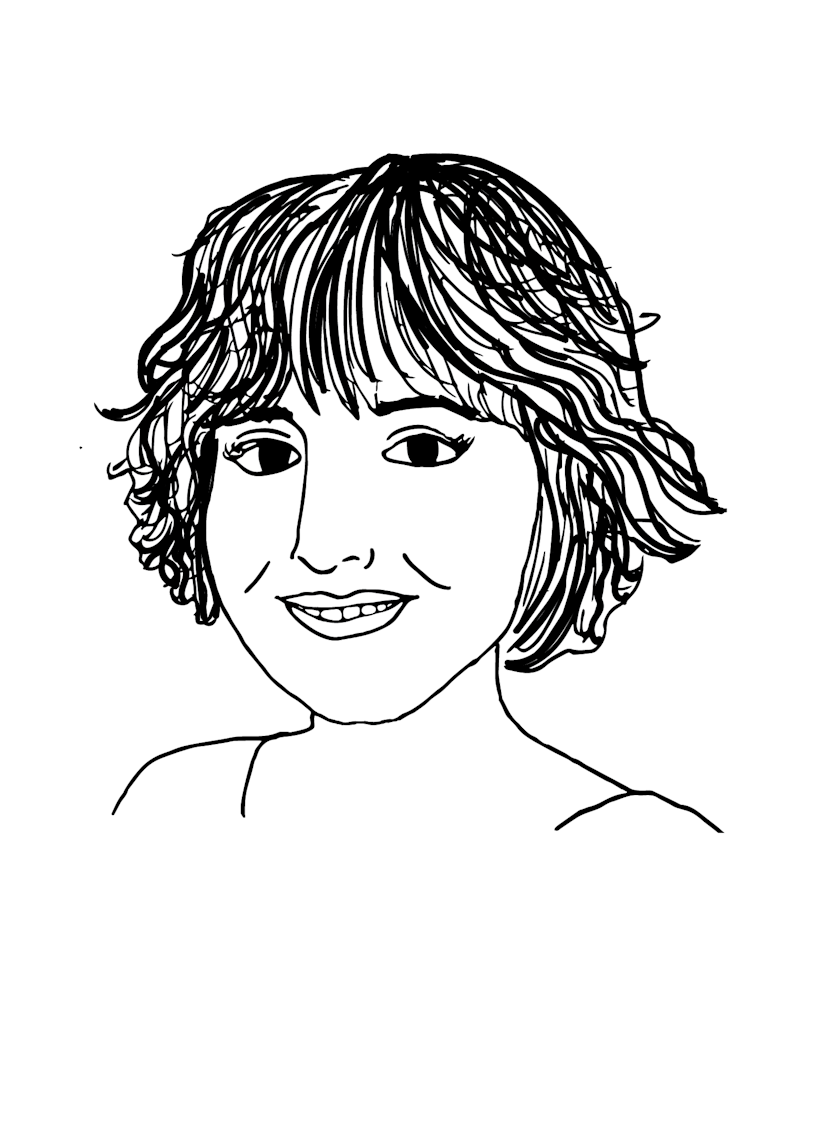During the pandemic, Iranian-born, Connecticut-based artist Arghavan Khosravi became frustrated by scale. Unable to work on large pieces in her quarantine space, she decided to fragment the canvas and bring it off the wall. Now, her caught but never complacent women—who had hitherto been relegated to two dimensions—erupted into the third. The threads that had ensnared the paintings now looped from the wall, suspended by earbuds or acting as chains to their ball counterparts. Though shackled, these women fracture out from their environs into new realms rendered on canvas, wood, plexiglass, leather, foam, even human hair—materials that the artist sources and constructs entirely on her own.
Now on view at the Rose Museum at Brandeis University, Khosravi’s first comprehensive museum survey, “Black Rain,” charts this progression, showcasing work from her time as a postbaccalaureate student at Brandeis until today. Enclosed by walls painted the Hockney-esque blues and greens found in Khosravi’s longed-for earthly utopias, the Rose Museum’s Henry and Lois Foster Director and Chief Curator Dr. Gannit Ankori has created a space that operates much like the interior worlds Khosravi’s protagonists retreat to, allowing the audience to participate in a silent but powerful resistance to the patriarchal violence that continues to oppress women in Iran specifically, and across the globe more broadly. Punctuated by Persian miniature illustrations loaned from the Harvard Art Museums and Museum of Fine Arts, Boston—a tradition that inspires Khosravi’s practice— “Black Rain” is a thrilling dive into the mind of an artist who believes that stories—the ones we tell ourselves, the ones we have access to, the ones that are told about us—have the power to grant us freedom.
Here, we discuss her ties to New England, her subconscious method of making, and how visual narratives can inform and sustain revolution.
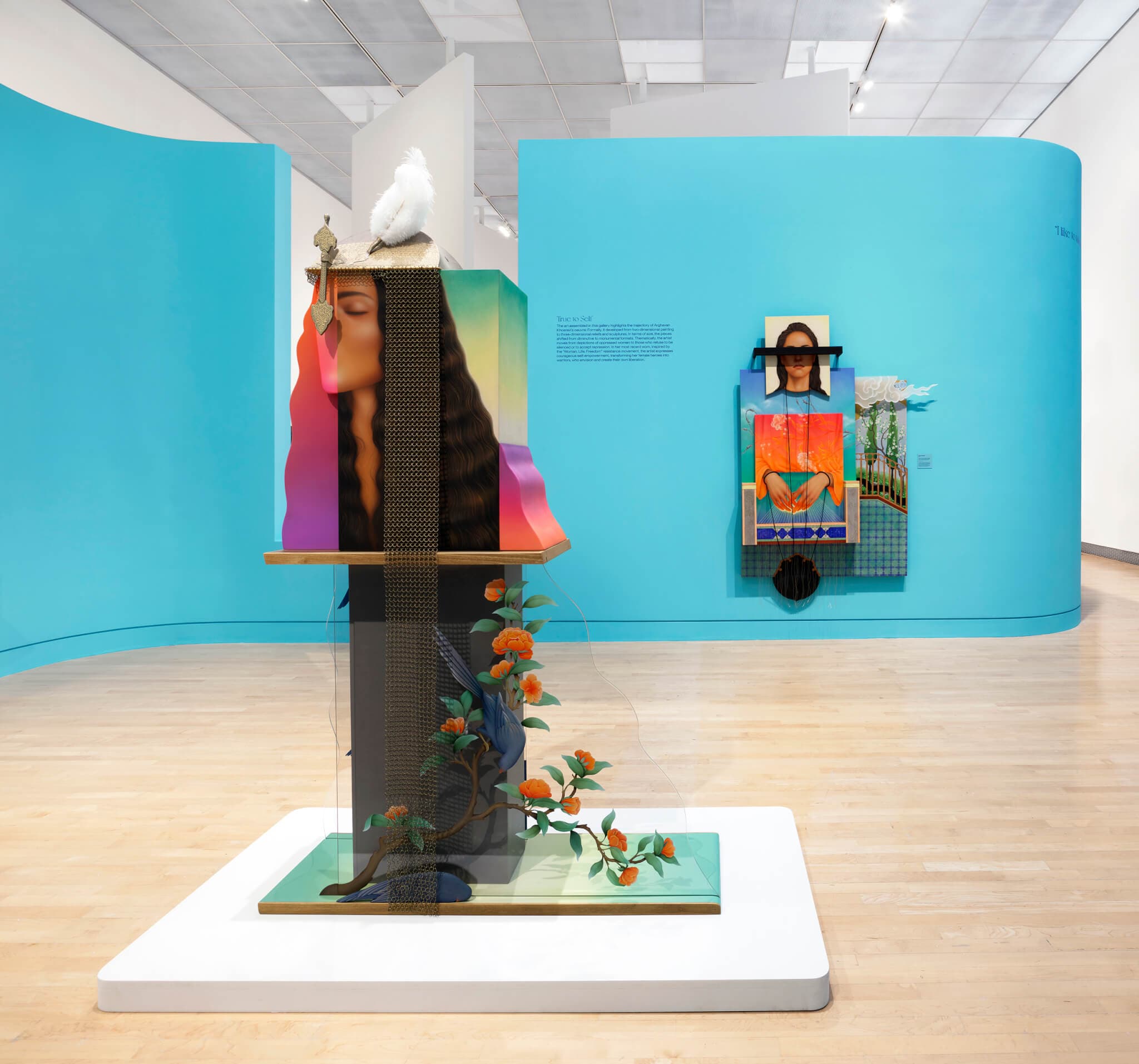
Installation view of “Arghavan Khosravi: Black Rain,” on view at the Rose Art Museum, Brandeis University from August 3–October 22, 2023. (left front) The White Feather, 2023, (right back) At her Fingertips, 2023. Photo by Julia Featheringill Photography. Photo courtesy Rose Art Museum.
JS: You came to Brandeis in 2015 from Iran to start your painting practice, and then you went to RISD for grad school. You’ve had a fellowship at Provincetown and you live and work in Connecticut. That’s a lot of New England right there. Do you feel like a New Englander?
AK: I haven’t lived anywhere else, so my experience of being an immigrant in the US is based on New England, which is very welcoming. Brandeis, and Boston in general, is where my journey as an immigrant—and as a painter—started.
JS: What does it feel like to be back at Brandeis for your first museum survey?
AK: Being here has brought back all the feelings I had when I first stepped on campus. I had only been in the United States for two weeks. I remember, at the end of that year, I was walking with two of my classmates; we were taking our works to the student gallery for the end-of-the-program show. And as a joke, I pointed to the Rose and I asked: “So when are we going to show there?” And we laughed! And in less than ten years, I’m coming back with this show. It’s wonderful.
JS: You’ve accomplished a remarkable amount in such a short time, and your journey to this exhibition is so interesting. As a young person in Iran, you made so many practical choices: first deciding to study math, then moving into graphic design, a field you worked in for ten years. Why did you decide to go for it as an artist?
AK: Art was always something that I was doing every day, but my thirteen-year-old self thought of it as leisure. In Iran, we have to choose our field of studies, unfortunately, in our second year of high school, and at that point I thought—and this is stupid— that smart students don’t go to art school.
My family really supported whatever decision I wanted to make, but when I went to college, I did think: graphic design is something that I can get hired to do. I can have a steady income; it’s something that, as you mentioned, is more practical. And I enjoyed those years of being a graphic designer, when I was also illustrating children’s books on the side. But there was a time when I did really want that freedom to express myself without having to cater to a client or a publisher.
JS: And painting offers you that.
AK: Art gives me the freedom to say whatever I want to say—as little or as much. And it also helps me to tap into my mind and memories on a subconscious level. Obviously when I recognize it happening, it’s not subconscious anymore. But as I’m working, I become aware of ideas and feelings as they come to the surface, which is fascinating. Sometimes it isn’t until I create an artwork and I can look at it as an object outside of myself that I realize things about myself. Take the works in this show for example. Gannit and I would have conversations so that she could create the texts and contextualize the pieces for the audience, and she would mention things that I didn’t even recognize–that I wasn’t conscious of. It was great!
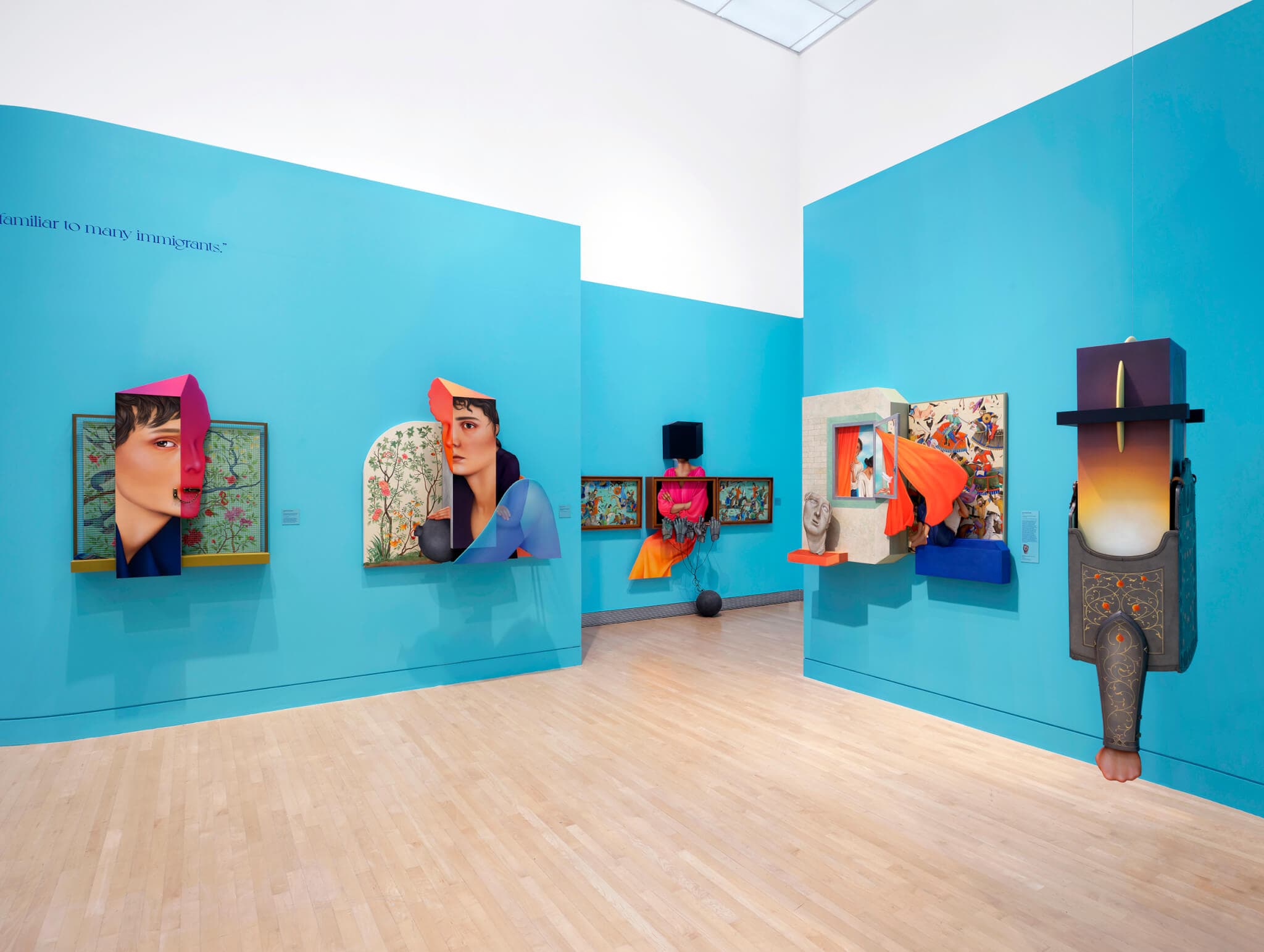
Installation view of “Arghavan Khosravi: Black Rain,” on view at the Rose Art Museum, Brandeis University from August 3–October 22, 2023. Photo by Julia Featheringill Photography. Photo courtesy Rose Art Museum.
JS: A practice driven by the subconscious is very in line with the surrealist movement, which is interesting because your works are almost always described as surreal, and you’re often called a modern surrealist. Do you identify with that movement? I ask because people seem to use that term now as a catchall for anything that looks dreamlike or fantastical.
AK: I don’t often describe myself as surrealist, but I am aware that there are a lot of surrealist elements in my work. As you said, this term has been overused or misused in so many different contexts. For me, exploring a space that cannot happen in real life is the interesting part. And also extracting images from my subconscious, which is important as a lot of my work deals with my memories and life experiences from home from Iran. I like to create spaces that float in between geographies and times, which I think gives the work a sense of surrealism.
JS: There is also that sense of storytelling and message-making that feels akin to the surrealists. Your work is often very narrative. Is this something that has carried over from your time in graphic design or illustration?
AK: When I started painting at Brandeis, it was the first time that painting was my main focus every day. I thought that I wanted to have a fresh start, and I told myself that I had to let go of all those things, all those experiences I had communicating specific messages. So, I started with abstraction. There was no narrative in my work and it was mostly process based. I was not enjoying what I was doing. The outcome wasn’t good. The feedback wasn’t good. Finally, I had to ask myself: why am I trying to escape from what is part of me? I deal with complex issues in my work, and abstraction is not a good form to express them. So that was how I started reincorporate narrative. First it was a bit of both—geometric forms and a bit of figuration—but with every year it became more clear that narrative is how I wanted to express my thoughts in my work.
JS: That’s such a universal experience: we think that in order to be taken seriously, we have to be the opposite of who we are. In your case, as a graphic designer, you did logo design, correct? There’s so much to learn from that: how to draw the eye to a specific place, how to drive home a point, how to communicate something very complex through a very concise visual. I can see how those skills really serve you in these pieces. You know how to keep the messaging from ever getting too opaque. You offer a way in or sometimes multiple ways in so people find new ways to engage with these difficult concepts. So, many of your superpowers are things that you felt you had to run away from. I think we can all identify with that.
AK: You’re right. My skills and experiences as a graphic designer really helped me form an aesthetic, which now I’m using in my painting practice: the attention to composition and color, and also the way I use light in my work. The action occurs under a standard light—what you expect from commercial photography. That didn’t happen intentionally, but now I’m aware that it serves my aesthetic, and also the sense of surrealism that I cultivate, because the work appears as though it’s staged.
Sometimes I worry that, with my graphic design background, I pay too much attention to the composition, the colors, the harmony. But because the subject matter can be very uncomfortable and unsettling, that harmonious composition and color palette acts as an invitation for the audience to look at them. It also serves a sense of contradiction that I’m always exploring in my work.
JS: Which brings me to a technical question, because when you see these works in person, you’re struck by just how immaculate the work is. You can’t see a single brush stroke. How do you achieve that?
AK: I use airbrush for larger areas and acrylic with normal brushes for smaller areas, but yes, I don’t like to see brush strokes. I wasn’t trained as a painter; for me it was more trial and error. I didn’t have the patience for oil to dry so I decided to use acrylic. And when I was an illustrator, I used mostly watercolor so I already knew water-based mediums. The way I use acrylic is sometimes similar to watercolor, with a lot of translucent layers. I glaze over and over to achieve certain darkness or tones instead of mixing colors on the surface. I like the scenes to be very smooth, to create idealistic imagery in unsettling situations.
JS: I know you look to fashion photography—among other things—when you begin a new work. How do these references support your investigations of an idealized image?
AK: I’m aware of the fact that fashion photography imposes specific beauty standards on women which rightfully draws a lot of criticism. But when I’m appropriating or being inspired by those images, I’m mostly considering their poses and their facial expressions—because they maintain this neutral aspect. This plays into my interest in contrast or contradictions; I want the face to be in contrast to what’s actually happening to that person. Perhaps she’s shackled or in an uncomfortable situation, but the expression on her face is neutral, which under that specific circumstance projects power. I don’t want it to seem that the women in my works are weak or are suffering.
JS: Those sorts of registers–suffering–give the audience an easy out sometimes. They can default to sympathy and just move on rather than engaging.
AK: You’re right about that. But also, I just want to reflect what is actually happening. Because right now in Iran, women are not weak. They’re standing up, they’re trying to take control to change things.
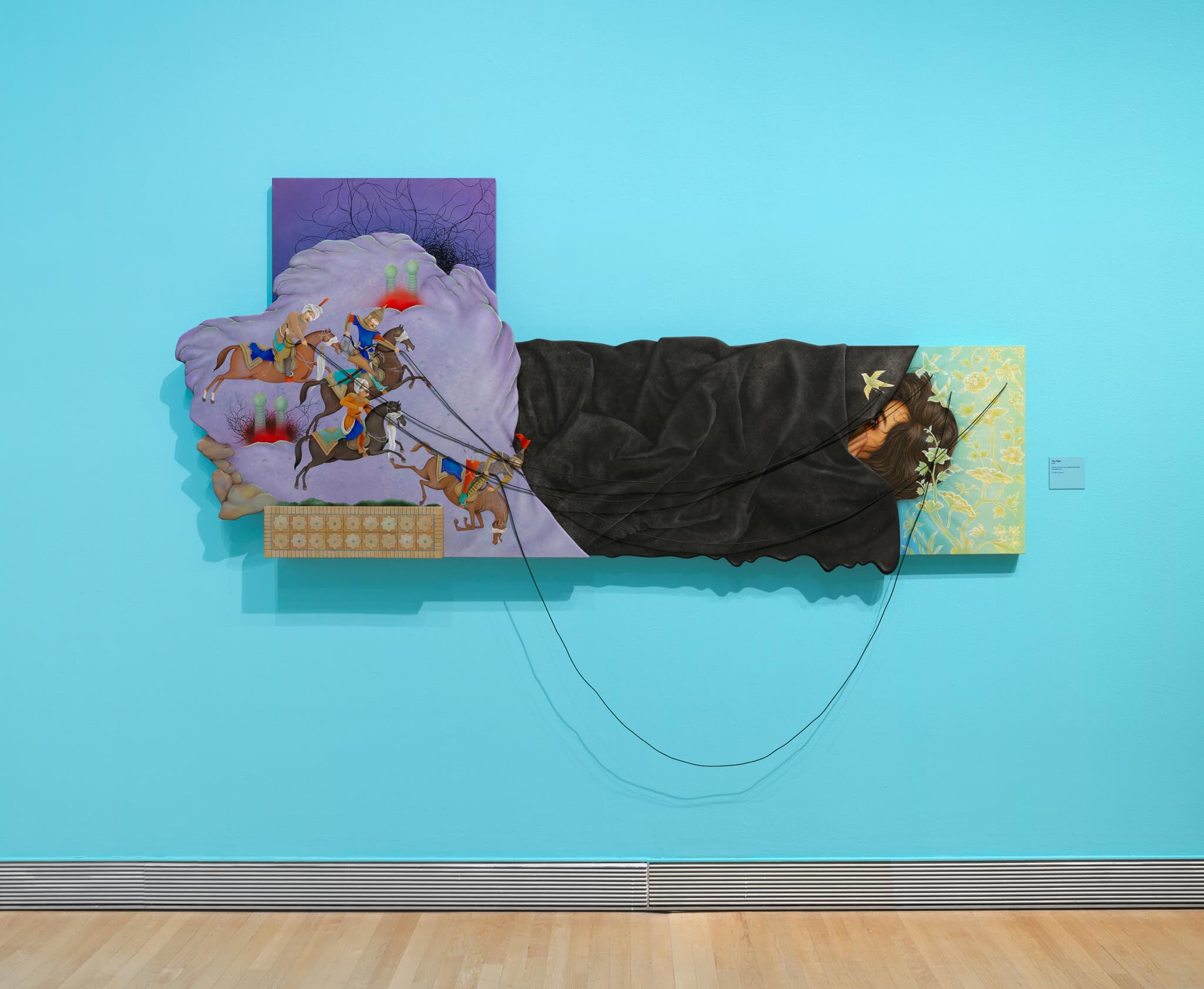
Installation view of “Arghavan Khosravi: Black Rain,” on view at the Rose Art Museum, Brandeis University from August 3–October 22, 2023. (pictured) The Flight, 2023. Acrylic on canvas over shaped wood panels, elastic cord. 49″ x 97.5″ x 5″. Photo by Julia Featheringill Photography. Photo courtesy Rose Art Museum.
JS: Let’s dive into the iconography you use to communicate that resistance, because you do employ a number of recurring motifs—and because this show spans your entire professional career, we can really see how your use of them has evolved. I was struck by The Bird (2023) specifically, because I believe this is the first time that no human figure—or at least body part—is depicted.
AK: Oh wow. That’s an interesting observation because I didn’t notice that. But you’re right, now that I’m thinking about it, it is the first time that there is no body part actually depicted.
JS: That’s amazing. I assumed it was intentional, but it’s wonderful that it’s not. We’ll learn later on if it means anything, which just illustrates your points earlier about your subconscious way of working. Let’s talk about your use of Greco-Roman busts then, which we see again and again in your work, and features heavily in Black Rain (2021), which is the piece the show is titled after. Here we see the oil raining down from the broken head of a Greek King, and the immediate inference is patriarchal repression and also the role of the West in commodifying the middle east.
AK: Part of my fascination with these sculptures is that, when they were made, they were meant to depict that idealized human body. But over time they became broken and cracked. That captures a contradiction which is, as we discussed, what I’m always exploring in my work. And yes, they represent patriarchy. They do operate, and I do use them, to communicate a sort of Western value system, but also just patriarchy more generally. Because unfortunately, that’s something that exists universally on different levels. It’s something that we’ve dealt with throughout history, and of course the fight for equality is still ongoing. So, I’m bringing the objects from history into the present day to make that connection—we’re still dealing with this.
JS: Red thread, or red cord, is another recurring motif that typically symbolizes repression, or at least boundaries, in your work, but in True to Self (2023), which is your first free standing piece, and is on view at the Rose, we see it as an earbud cord, and it feels empowering—or perhaps that its providing a sense of safety. Did you consciously reverse the meaning of this image?
AK: It’s not as rigid as that, that there are rules. In my previous works I did use the red string to visualize all the boundaries, restrictions, and red tape that, based on my own experiences, are imposed by the government. But everyone can relate to it differently. In True to Self, I didn’t have those metaphors in my mind. First, the color just offers some contrast to the rest of the piece, which—in terms of the palette—is very toned down. And the headphones themselves bring the piece to a contemporary time. Also, the red gives the action of listening more importance.
In most of these freestanding pieces, I’m exploring duality. Each side is in contrast with the other. In this piece, her eyes are closed, she’s listening to music as if she’s not paying attention to her surroundings; it’s an inward situation. But when you take a closer look and notice the reflection of the other side in the mirror, you see that she’s staring back at you.
JS: She’s aware.
AK: I don’t like to overexplain, but yes. Sometimes women appear as if they are not paying attention or are indifferent to what is going on and what’s happening to them. But in fact, they are aware and they are fighting back. Take the case of Iran and the Zan. Zendegi. Azadi. (Woman, Life, Freedom) protests. They were crushed. And if you go to Tehran now and see women on the streets, you think it’s life as normal and people are not resisting anymore. But they continue to refuse to wear the compulsory hijab on the street; they’re risking their freedom, even their lives by doing that. It’s an act of resistance. So they may seem to be indifferent to their surroundings and not reacting to what’s happening to them, but below the surface they’re fighting every day.
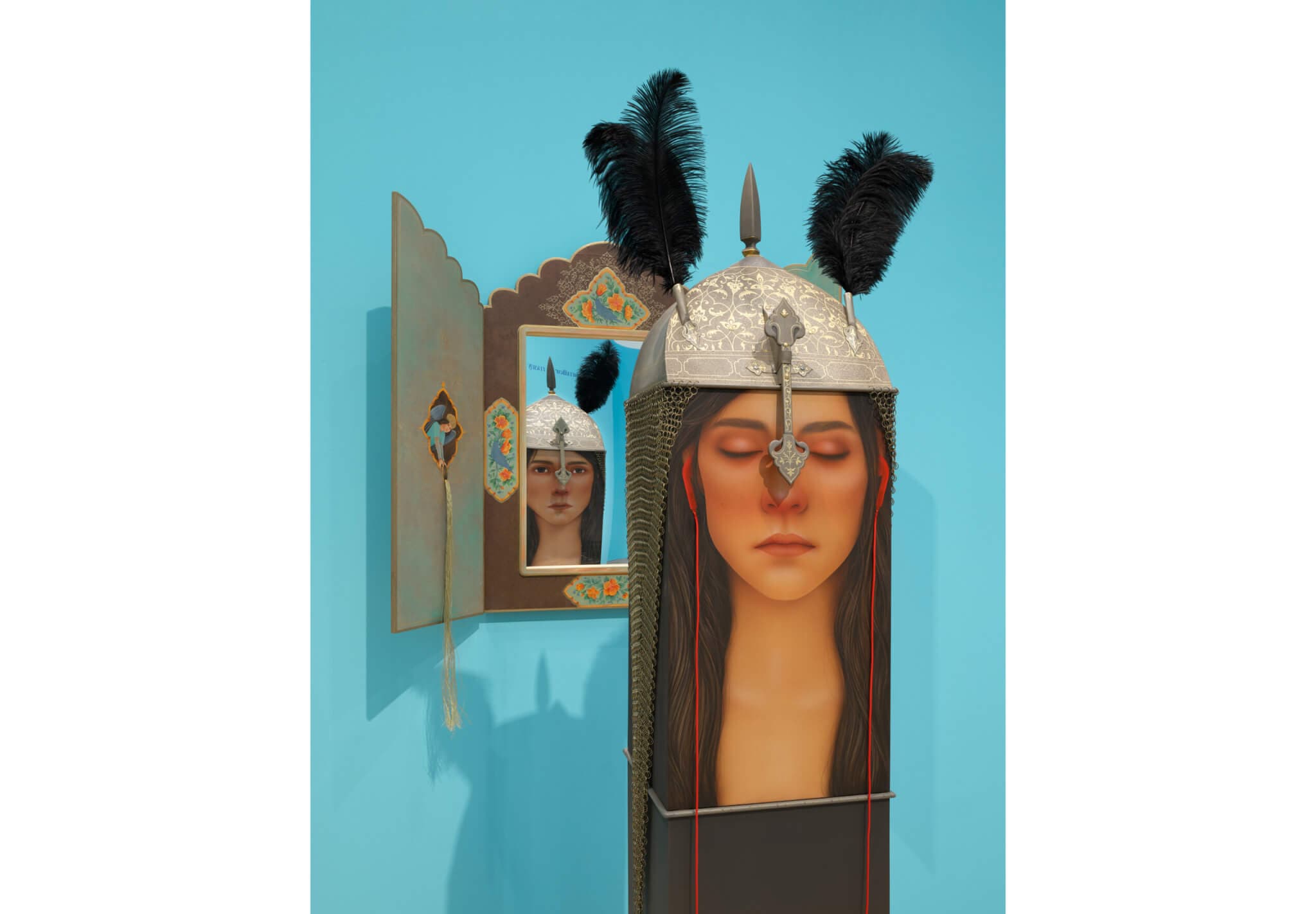
Installation view of “Arghavan Khosravi: Black Rain,” on view at the Rose Art Museum, Brandeis University from August 3–October 22, 2023. (pictured) True to Self, 2023. Acrylic on canvas and textile over wood panels, feather, chainmail, elastic cord, mirror, thread, 83″ x 5″1 x 36″ (HWD). Photo by Julia Featheringill Photography. Photo courtesy Rose Art Museum.
JS: The Zan. Zendegi. Azadi. movement was a major inspiration for a lot of the new work that you have on view in this show; you made a remarkable amount of new work that folks can see in addition to some of your older pieces. Something that struck me was that it seems the pomegranate, which has always appeared in your work—but much more sparingly—is more prevalent in these more recent pieces. Pomegranates are very important in Persian culture. Was there a specific intention behind featuring them here?
AK: A painter friend of mine who is also Persian made the joke that we Persian artists need to paint a pomegranate every once in a while. But seriously, in these works the pomegranate acts as the counterpart to the negative elements you see in the paintings. There are paradisiacal landscapes even while all of these horrible things are happening. It’s the answer to: What are we hoping for? Those landscapes represent a utopia—but not in an idealistic, unreachable way. Here, on Earth.
JS: Why that distinction? Why is it important that paradise remains something attainable and real?
AK: Because the issues that my mind is grappling with belong on Earth. That’s where these terrible things are happening. So when I’m thinking about what is on the other side of the path we’re on, it’s also something on Earth. The ideal space is just having equal rights. When I put it into words it sounds very crude or didactic, so that’s why I find imagery a more powerful mode of expression. I take symbolism from religious contexts and bring it into a secular realm, because in Iran, the government uses religion to control people. I take motifs like the arabesque—part of the visual elements that the Iranian government uses for its own propaganda—and I subvert it. I want to say: These are not only for you and the way you utilize or exploit them. I can take this. I can have them in my own way.
JS: It’s resistance.
AK: It is.
“Arghavan Khosravi: Black Rain” is on view at the Rose Art Museum at Brandeis University through October 22, 2023.





